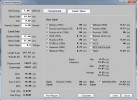In addition to the functions and facilities as described in the relevant sections for each ship type, ANKO offers a number of specialized modules which over the years have been proved very useful both on-board and in the office.
- Squat estimation is essential when vessel enter rivers or narrow and shallow channels
- Speed Correction for environmental conditions and currents is a valuable tool for checking the performance of the vessel against charter party agreed speed
- Trim Optimization enables the operators to pre-plan the trim and/or speed so that an improved resistance and, consequently, fuel savings are achieved for the required vessel's displacement
- Auto Ballast is a ship specific module of the ANKO Marine Load Planner which solves the actual problem of vessel's ballasting for achieving the 'Optimum' Trim within Stability and other Operational constraints.
It is noted that additional facilities for the evaluation and improvement of the performance of the vessel can be found in SEMT - Ship Efficiency Monitor Toolkit - software package.
Squat estimation
The Squat is estimated using well established approximate simplified calculation methods.
More than ten calculation methods are used to estimate the maximum squat and the under keel clearance for selected vessel’s speed values.
The calculation is available both for 'Unrestricted' waters or confined 'Channels/River'.
The Squat and Clearance results are displayed for each individual method, as well as the min/max and average or weighted average squat.
A detailed report is produced, which includes a speed-squat table for the master's reference.
Speed Correction
This module corrects the observed speed of the vessel, to a speed corresponding to calm sea, without wind and current effects or to a reference sea-state as stipulated in the charter party.
For carrying out the above, ship-specific information is combined with well established experimental prediction methods, to convert the added resistance due to the:
- Sea State (wave height and direction)
- Wind (force in BF and direction)
- Current (speed and direction)
into gain/loss of power and hence speed. Thus for the actual Draft and Trim of the vessel the corrected speed is estimated.
Trim Optimization
With this module, pre-planning of the target trim and speed is enabled, so that an improved resistance and, consequently, fuel consumption is achieved for the required vessel's displacement.
For a given displacement and various vessel speeds, a variation of trims with respect to power is estimated and displayed in a graphical interactive screen. Hence, for fuel saving, the 'best' trim may be selected. Percentage differences of other trims and speeds with respect to the optimum are calculated and displayed.
Similarly, for a constant speed and various displacements the variation of trims with respect to power is estimated and displayed graphically. This way the effect of the addition of ballast required to trim the vessel on resistance is estimated.
Trim Optimization may be used as stand-alone or as module of ANKO. For any vessel displacement and as a stand-alone tool, it may be used to advise the master on how to trim his vessel. When Trim Optimization is used as an integral part of ANKO, then the user/master gets a direct answer on what the 'best' trim is and how it can be achieved by redistributing cargo, or ballast. Furthermore, the dynamic trim is also assessed, so that both the static and corresponding dynamic trims are available for load planning. Other critical factors such as propeller immersion are calculated and displayed.
For carrying out the above, a 3D model of the vessel's hull form is used, so that all necessary information such as wetted surface area, hull form factors, immersed transom area, longitudinal centre of buoyancy are calculated for the power estimation.
Auto-Ballast for Trim Optimization
Auto-Ballast is a ship specific module of the ANKO Marine Load Planner which solves the actual problem of vessel's ballasting for achieving the 'Optimum' Trim within Stability and other Operational constraints.
Auto-Ballast uses CFD or other Resistance data and takes into account:
- The Actual Loading condition
- The Ballast Tanks' capacities, geometry and location
- The engine's SFOC curve
- The "Optimum" Resistance/Consumption for all Operational Trims.
- The Ballast-Trim combinations that can be achieved using the vessel's ballast tanks and the actual vessel's loading. The Ballast-Trim area is shaded to indicate the cases where the stability criteria are satisfied.
- Limiting KG (or multiple KGs) for Intact and/or Damage
- Minimum GM - can be increased by User
- Mid Draft and/or maximum Displacement
- Propeller Immersion
- Minimum Fore Draft - can be increased by User
Ballasting Process for Optimum Trim
- The vessel's current loading including ballast is automatically taken from ANKO
- The ballasting process is straight forward and performed on a single screen
- The proposed loadings satisfy all Statutory and Operational Constraints
- The calculated ballasting can automatically reconfigure the vessel's loading to the required "optimum" Trim
